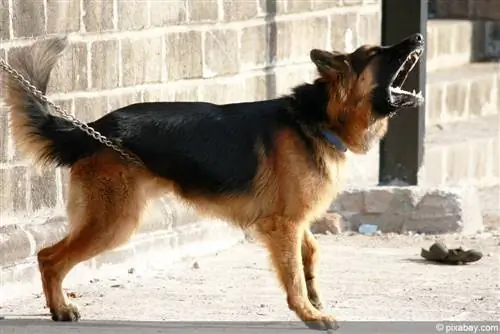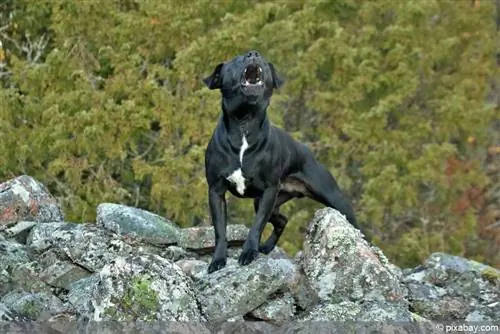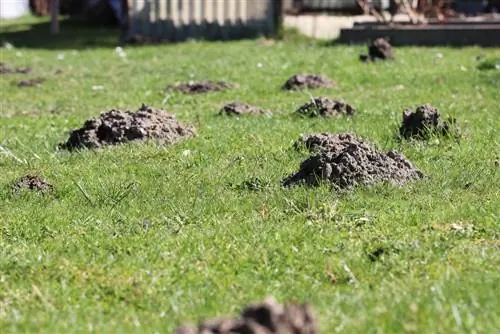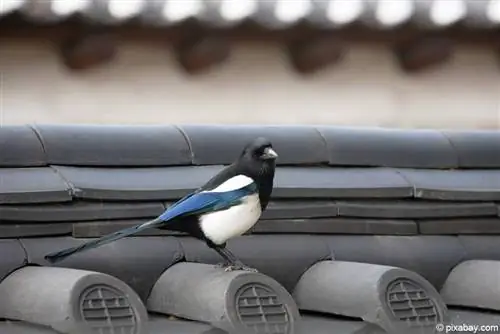- Author admin [email protected].
- Public 2023-12-17 03:39.
- Last modified 2025-06-01 06:48.
Dogs are popular pets - but unfortunately they can also become a nuisance or even dangerous when left loose. Sometimes it is therefore necessary to drive them away. You don't have to be aggressive at all. Simple home remedies are usually enough to keep your four-legged friends away. From noises to smells - what helps and what doesn’t is revealed here.
Secure property
The simplest and most permanent way to keep dogs out is to secure your own property with a fence. This may seem unfair if the dogs repeatedly cause mischief on other people's properties due to inattentive or even irresponsible owners. In the long term, however, it is the option that requires the least effort.
The following options can also be used as alternatives to the classic fence:
- Lavender bushes, because dogs generally don't like the smell
- Hedges, dense and high, they form a natural barrier
- Thorn bushes, as long as there are not too many gaps between them
Talking
If the owners are known, you should talk to them. In fact, not everyone is always aware that dogs are not universally popular and welcome at all times. Be it due to allergies, fear or legacies - in many cases a common solution to the existing problem can be found through a conversation.
Smells

Not only male dogs like to mark their territory, female dogs also leave their scent. This may not be so bad if it's just a dog. As a rule, however, it doesn't stay that way. Instead, the smell entices others to also mark the fence or grass. If you want to prevent this, you can counteract it with smells. Suitable items include:
- Lavender
- Peppermint
- Vinegar
- Baking powder
- Pepper
Tip:
The smells disappear relatively quickly outdoors, which is why they should be applied every few weeks.
Lavender
Pleasant for human noses, but not for dogs' olfactory nerves - lavender in the marked areas can prevent future urination. So that the dogs don't simply place their scent mark a meter away, essential oil should be dripped onto the ground or wood along the fence or property line. Lavender plants usually don't smell strong enough, which is why they have little or no deterrent effect.
Peppermint
Like lavender, peppermint is fresh and even stimulates people's appetite. However, the smell is too strong and unpleasant for dogs' noses. Again, essential oil should be used, as this is particularly intense and therefore has a reliably deterrent effect.
Vinegar
The smell of undiluted vinegar or even vinegar essence is so intense that even people find it unpleasant. Dogs even more so because of their more sensitive olfactory nerves. It is a good idea to spray it on the affected areas. However, when using it, it should be noted that the smell of vinegar disappears quickly. Therefore, in some cases it even needs to be sprayed daily for a lasting effect. It also acts as a natural weed killer and acidifies the soil. It should therefore not be applied directly to plants or the soil. For fences and walls, however, it is a cost-effective means of deterring dogs.
Baking powder
Baking soda neutralizes odors, which is why it can neutralize or at least weaken urine markings. The baking soda can be applied dry to the affected areas or diluted with a little water. It should be noted, however, that baking powder does not have a direct deterrent effect. It simply makes the fence and ground less attractive for marking by neutralizing urine odors. It therefore makes sense to use a deterrent scent after the application.
Pepper
Pepper does not have a deterrent effect directly because of the smell, but because it irritates the nasal mucous membranes and thereby triggers sneezing. It should therefore only be used when other means fail. It is enough to add ordinary ground pepper to frequently marked areas or to sprinkle it in a line around the property, as it were, as an additional border.
Repellents from the trade

Instead of home remedies, dog repellent products from specialist retailers can also be used. However, care should be taken to ensure that these do not pose a danger to the animals.
Sounds
You can find dog repellent devices in stores that use ultrasound to produce an unpleasant noise. However, these usually don't work for all dogs, but they can deter other animals - including beneficial insects. In addition, the whining noise can also be unpleasant for people. Younger people in particular usually still notice the high tone and can find it stressful.
However, there are other ways to keep dogs away from the property by making noises. These include:
- Shake cans and bottles
- Rustling Bags
- Ratchets
Shake cans and shake bottles
Fill a lockable can or bottle with coins, stones or bottle caps and throw them on the ground to ward off a dog - not on the dog itself. The loud noise when it hits the ground acts as a deterrent and ensures that the Four-legged friends associate the property and the thrower with an unpleasant experience. This measure only works if the dog is caught “in the act”, but it also works on walks, for example.
Rustling Bags
Empty bags made of crackling plastic are simple, easy to use and loud - making them ideal for scaring dogs. To use them, they are grabbed by the handles and thrown abruptly from top to bottom. In this way the air gets caught in it and a kind of bang is created. Most dogs generally dislike the rustling, crackling and unpredictable movements of plastic bags in the wind. Therefore, they can also be attached to bushes or the fence, for example. Here they only serve as a deterrent when there is just enough wind.
Ratchets
Fan item ratchets are basically noisemakers - ideal for fending off dogs with noise. The ratchets are simply turned and produce a loud, unpleasant noise. Again, they only serve to scare dogs when they are in the immediate vicinity. However, they offer the advantage of being light in weight and easy to use.
Motion detector
Another way to drive away dogs is to connect a motion detector to a sprinkler system. If the four-legged friend runs across the property, it triggers the motion detector and sets the lawn sprinkler in motion. If the dog doesn't want to get wet, he will run away. However, there are definitely dogs who don't find water intimidating, but on the contrary, start chasing the jets of water and are grateful for the cooling. In addition, on heavily frequented properties, the lawn could quickly become overwatered. In addition, the motion detector must be turned off each time so that the residents themselves don't get wet. In many cases, this variant is not the ideal solution for driving dogs away.
Heat

When female dogs are in heat, they smell particularly attractive to male dogs. It is not uncommon for male dogs to run away for this reason, sometimes covering several kilometers, jumping over high fences or digging under them. Once they get to the lady dog, they are often difficult to drive away, even with deterrents. In order to reduce the attractive effect of your own bitch in heat, her scent can be weakened by the coordinated administration of chlorophyll and by bathing. For example,Chlorophyll is available in the form of tablets and is also used in humans to minimize body odor. For optimal effect, administration should begin before the heat begins.
Caution:
Don't scare off attack!
If a strange dog keeps getting lost on the property, it can be very annoying. Especially if he causes damage, leaves behind unsavory residue, chases other animals away or threatens territorial fights with the house dog. However, it is important not to attack the dog or push it into a corner. Even otherwise peaceful animals can then attack out of fear and self-preservation. It is better to drive your four-legged friend towards the property boundaries with the following emergency measures - where he can easily run away:
- Throwing shake cans, clapping your hands loudly
- Spray with water
- Fill bags or paper bags with air and let them burst
Note
Even if the dogs are not supposed to be on the property due to allergies or unwanted droppings, they must not be injured. If the dog keeps running onto the property, is injured and is not wearing any collar or harness, the following contacts can help:
- Vet or animal clinic
- Animal shelter
- animal rescue
- Veterinary Office
- Police






